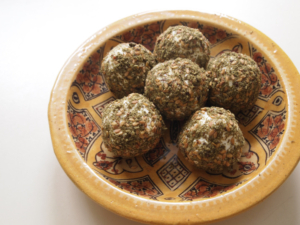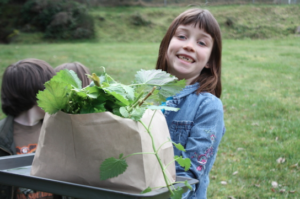 I knew nettles were good for us, but really, how good? To find out, I was inspired to get a lab sample of one of Galiano’s most prominent forageable foods. I then compared the analysis against the nutrient values of kale, broccoli, lettuce, spinach and 2% milk (you’ll see why) and the results blew me away. The data on the foods below came from the USDA Nutrient Database and the Canadian Nutrient File.
I knew nettles were good for us, but really, how good? To find out, I was inspired to get a lab sample of one of Galiano’s most prominent forageable foods. I then compared the analysis against the nutrient values of kale, broccoli, lettuce, spinach and 2% milk (you’ll see why) and the results blew me away. The data on the foods below came from the USDA Nutrient Database and the Canadian Nutrient File.
Most surprising to me was that nettles have the highest calcium content of all these foods.
Food Calcium Value per 100g
Nettles, Blanched 481mg
Kale, Raw 150mg
Milk, 2%, with Vitamins A & D 128mg
Spinach, Raw 99mg
Broccoli, Raw 47mg
Lettuce, Green Leaf, Raw 36mg
One would have to drink over three times as much milk to get the same quantity of calcium as one portion of nettles.
Nettles also exceed on the dietary fibre front:
Food Fibre Value per 100g
Nettles, Blanched 6.9g
Kale, Raw 3.6g
Milk, 2%, with Vitamins A & D 0g
Spinach, Raw 2.2g
Broccoli, Raw 2.6g
Lettuce, Green Leaf, Raw 1.3g
Two other mineral comparisons I thought I’d mention are magnesium and potassium. As you see in the chart below, nettles have relatively high amounts of both minerals. Comparatively, spinach has the highest magnesium and potassium value; and kale also exceeds nettles in potassium value.
Food Magnesium Value per 100g Potassium Value per 100g
Nettles, Blanched 57mg 334mg
Kale, Raw 47mg 491mg
Milk, 2%, with Vitamins A & D 14mg 162mg
Spinach, Raw 79mg 558mg
Broccoli, Raw 21mg 316mg
Lettuce, Green Leaf, Raw 13mg 194mg
There were many other interesting comparisons, but the ones above were the main highlights. As we head into an early spring, with nettle growth well underway, I’m going to try to make the most of nettle harvesting, drying and storing. Move over milk and make way for those nettle smoothies!
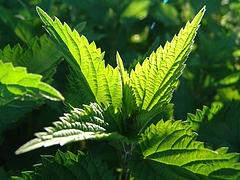 Come together to celebrate the return of Spring as we gather as a community for the 8th annual Nettlefest Potluck. It’s all about gathering with friends and neighbours, sharing some wonderful food, and enjoying the entertainment of some amazingly-talented locals. Join us, and bring something to share with others.
Come together to celebrate the return of Spring as we gather as a community for the 8th annual Nettlefest Potluck. It’s all about gathering with friends and neighbours, sharing some wonderful food, and enjoying the entertainment of some amazingly-talented locals. Join us, and bring something to share with others.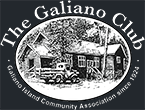
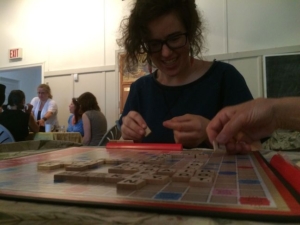 Come join us at the South Hall for a raucous evening of games with your friends and neighbours!
Come join us at the South Hall for a raucous evening of games with your friends and neighbours!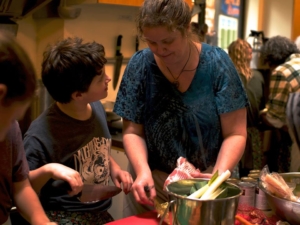 Soup and Bread (formerly known as Meals for Seniors) is one of the most loved and successful projects the Food Program runs. I’d love to say we planned it that way—but of course we did not.
Soup and Bread (formerly known as Meals for Seniors) is one of the most loved and successful projects the Food Program runs. I’d love to say we planned it that way—but of course we did not.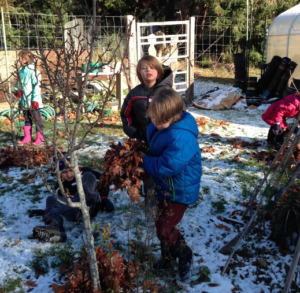 December was ushered in with the Great Bigleaf Rake-Up at the school garden. With maple leaves buried under a dusting of crunchy snow, blue sky above, Galiano School kids gathered around two large maple trees on the school property to learn about densely rich maple leaves and the value they bring to other plants when composted. The kids were divided into four teams: Calcium, Magnesium, Potassium, and Nitrogen, and each team learned some interesting facts about these four elements that figure prominently in maple leaves. What also became quickly apparent was how humans and plants require the same nutrients in order to thrive! For example, blossom End Rot in tomatoes and osteoporosis in humans are both related to calcium deficiency. In another example, magnesium is required by plants to process and use amino acids, vitamins, and proteins, and similarly for humans, magnesium is used to process other elements, notably calcium and potassium. Whereas magnesium deficiency will result in yellow, veiny leaves in plants, a deficiency in humans will impact the functioning of muscles and organs.
December was ushered in with the Great Bigleaf Rake-Up at the school garden. With maple leaves buried under a dusting of crunchy snow, blue sky above, Galiano School kids gathered around two large maple trees on the school property to learn about densely rich maple leaves and the value they bring to other plants when composted. The kids were divided into four teams: Calcium, Magnesium, Potassium, and Nitrogen, and each team learned some interesting facts about these four elements that figure prominently in maple leaves. What also became quickly apparent was how humans and plants require the same nutrients in order to thrive! For example, blossom End Rot in tomatoes and osteoporosis in humans are both related to calcium deficiency. In another example, magnesium is required by plants to process and use amino acids, vitamins, and proteins, and similarly for humans, magnesium is used to process other elements, notably calcium and potassium. Whereas magnesium deficiency will result in yellow, veiny leaves in plants, a deficiency in humans will impact the functioning of muscles and organs. How can I make my food supply more local? Why can’t I find seeds for those varieties my grandmother grew in her garden? How do I save seeds from plants that cross-pollinate? What do we need to do to start a seed bank on Galiano?
How can I make my food supply more local? Why can’t I find seeds for those varieties my grandmother grew in her garden? How do I save seeds from plants that cross-pollinate? What do we need to do to start a seed bank on Galiano? The Garlic Co-op is a group of garlic enthusiasts who collectively grow a few varieties of organic premium garlic, with scapes, in a large, shared, sunny plot at the end of Morgan Road, at the south end of the island. Together we learn about this easy-to-grow, hardy crop, share the load of bed-preparation, seeding, weeding, mulching and harvesting, and enjoy some delicious garlic. We also explore various soil-building and composting techniques. Everyone is welcome, and no previous experience is required to join. If you’re interested, come on out to a work party. Email galianofoodprograms@gmail.com for more info.
The Garlic Co-op is a group of garlic enthusiasts who collectively grow a few varieties of organic premium garlic, with scapes, in a large, shared, sunny plot at the end of Morgan Road, at the south end of the island. Together we learn about this easy-to-grow, hardy crop, share the load of bed-preparation, seeding, weeding, mulching and harvesting, and enjoy some delicious garlic. We also explore various soil-building and composting techniques. Everyone is welcome, and no previous experience is required to join. If you’re interested, come on out to a work party. Email galianofoodprograms@gmail.com for more info. I knew nettles were good for us, but really, how good? To find out, I was inspired to get a lab sample of one of Galiano’s most prominent forageable foods. I then compared the analysis against the nutrient values of kale, broccoli, lettuce, spinach and 2% milk (you’ll see why) and the results blew me away. The data on the foods below came from the USDA Nutrient Database and the Canadian Nutrient File.
I knew nettles were good for us, but really, how good? To find out, I was inspired to get a lab sample of one of Galiano’s most prominent forageable foods. I then compared the analysis against the nutrient values of kale, broccoli, lettuce, spinach and 2% milk (you’ll see why) and the results blew me away. The data on the foods below came from the USDA Nutrient Database and the Canadian Nutrient File. I have the Blue penicillin mold strain for blue-veined cheese.
I have the Blue penicillin mold strain for blue-veined cheese.